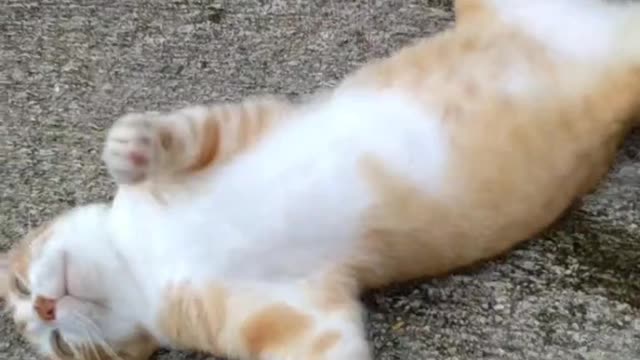Premium Only Content

Cat is getting tired and then take rest
The earliest known indication for the taming of an African wildcat (F. lybica) was excavated close by a human Neolithic grave in Shillourokambos, southern Cyprus, dating to about 7500–7200 BC. Since there is no evidence of native mammalian fauna on Cyprus, the inhabitants of this Neolithic village most likely brought the cat and other wild mammals to the island from the Middle Eastern mainland.[48] Scientists therefore assume that African wildcats were attracted to early human settlements in the Fertile Crescent by rodents, in particular the house mouse (Mus musculus), and were tamed by Neolithic farmers. This mutual relationship between early farmers and tamed cats lasted thousands of years. As agricultural practices spread, so did tame and domesticated cats.[11][6] Wildcats of Egypt contributed to the maternal gene pool of the domestic cat at a later time.[49]
The earliest known evidence for the occurrence of the domestic cat in Greece dates to around 1200 BC. Greek, Phoenician, Carthaginian and Etruscan traders introduced domestic cats to southern Europe.[50] During the Roman Empire they were introduced to Corsica and Sardinia before the beginning of the 1st millennium.[51] By the 5th century BC, they were familiar animals around settlements in Magna Graecia and Etruria.[52] By the end of the Roman Empire in the 5th century, the Egyptian domestic cat lineage had arrived in a Baltic Sea port in northern Germany.[49]
During domestication, cats have undergone only minor changes in anatomy and behavior, and they are still capable of surviving in the wild. Several natural behaviors and characteristics of wildcats may have pre-adapted them for domestication as pets. These traits include their small size, social nature, obvious body language, love of play and relatively high intelligence. Captive Leopardus cats may also display affectionate behavior toward humans but were not domesticated.[53] House cats often mate with feral cats,[54] producing hybrids such as the Kellas cat in Scotland.[55] Hybridisation between domestic and other Felinae species is also possible.[56]
Development of cat breeds started in the mid 19th century.[57] An analysis of the domestic cat genome revealed that the ancestral wildcat genome was significantly altered in the process of domestication, as specific mutations were selected to develop cat breeds.[58] Most breeds are founded on random-bred domestic cats. Genetic diversity of these breeds varies between regions, and is lowest in purebred populations, which show more than 20 deleterious genetic disorders.
-
 1:14:05
1:14:05
DeVory Darkins
16 hours agoDemocrats get BAD EPSTEIN NEWS after major mistake
181K142 -
 2:29:10
2:29:10
Badlands Media
10 hours agoDevolution Power Hour Ep. 406: Cracks in the Empire
238K22 -
 2:55:16
2:55:16
TimcastIRL
8 hours agoNEW Epstein Emails Drop, Dems Claim TRUMP KNEW, Congress Forces Epstein Release Vote | Timcast IRL
259K113 -
 1:19:53
1:19:53
Barry Cunningham
7 hours agoBREAKING NEWS: PRESIDENT TRUMP RE-OPENS THE UNITED STATES GOVERNMENT!
45.2K19 -
 20:47
20:47
The White House
8 hours agoPresident Trump Signs Senate Amendment to H.R. 5371
39.2K34 -
 4:37:57
4:37:57
Drew Hernandez
1 day agoNEW EPSTEIN EMAIL DROP FULLY POLITICIZED
63.5K28 -
 1:44:01
1:44:01
Tucker Carlson
7 hours agoTucker Carlson on the Israel First Meltdown and the Future of the America First Movement
74.8K443 -
 4:02:08
4:02:08
Alex Zedra
7 hours agoLIVE! Phasmaphobia New Map!
59.9K3 -
 2:16:06
2:16:06
Laura Loomer
9 hours agoEP155: Jihad Makes Its Move On The White House
51.9K63 -
 2:18:47
2:18:47
TheSaltyCracker
9 hours agoDem's Epstein Drop Backfires ReeEEStream 11-12-25
114K220